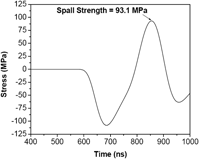Crossref Citations
This article has been cited by the following publications. This list is generated based on data provided by
Crossref.
Youssef, G.
Crum, R.
Prikhodko, S. V.
Seif, D.
Po, G.
Ghoniem, N.
Kodambaka, S.
and
Gupta, V.
2013.
The influence of laser-induced nanosecond rise-time stress waves on the microstructure and surface chemical activity of single crystal Cu nanopillars.
Journal of Applied Physics,
Vol. 113,
Issue. 8,
Gupta, V.
and
Youssef, G.
2014.
Orientation-Dependent Impact Behavior of Polymer/EVA Bilayer Specimens at Long Wavelengths.
Experimental Mechanics,
Vol. 54,
Issue. 6,
p.
1133.
2015.
Elastomeric Polymers with High Rate Sensitivity.
p.
187.
2015.
Elastomeric Polymers with High Rate Sensitivity.
p.
17.
Youssef, George
and
Whitten, Ian
2017.
Dynamic properties of ultraviolet-exposed polyurea.
Mechanics of Time-Dependent Materials,
Vol. 21,
Issue. 3,
p.
351.
Ramirez, B. J.
Kingstedt, O. T.
Crum, R.
Gamez, C.
and
Gupta, V.
2017.
Tailoring the rate-sensitivity of low density polyurea foams through cell wall aperture size.
Journal of Applied Physics,
Vol. 121,
Issue. 22,
Ramirez, B.J.
and
Gupta, V.
2018.
Evaluation of novel temperature-stable viscoelastic polyurea foams as helmet liner materials.
Materials & Design,
Vol. 137,
Issue. ,
p.
298.
Youssef, George
Brinson, Joseph
and
Whitten, Ian
2018.
The Effect of Ultraviolet Radiation on the Hyperelastic Behavior of Polyurea.
Journal of Polymers and the Environment,
Vol. 26,
Issue. 1,
p.
183.
Ramirez, B.J.
Misra, U.
and
Gupta, V.
2018.
Viscoelastic foam-filled lattice for high energy absorption.
Mechanics of Materials,
Vol. 127,
Issue. ,
p.
39.
Che, Kaiyuan
Lyu, Ping
Wan, Fei
and
Ma, Mingliang
2019.
Investigations on Aging Behavior and Mechanism of Polyurea Coating in Marine Atmosphere.
Materials,
Vol. 12,
Issue. 21,
p.
3636.
Jiang, Yuexin
Zhang, Boyi
Wei, Jianshu
and
Wang, Wei
2019.
Study on the impact resistance of polyurea-steel composite plates to low velocity impact.
International Journal of Impact Engineering,
Vol. 133,
Issue. ,
p.
103357.
Do, Sophia
Huynh, Nha Uyen
Reed, Nathan
Mohammad Shaik, Atif
Nacy, Somer
and
Youssef, George
2020.
Partially-Perforated Self-Reinforced Polyurea Foams.
Applied Sciences,
Vol. 10,
Issue. 17,
p.
5869.
Singh, S.S.
and
Kitey, R.
2020.
Spall Characterization in Epoxy Via Laser Spallation.
Experimental Mechanics,
Vol. 60,
Issue. 7,
p.
969.
Youssef, George
Reed, Nathan
Huynh, Nha Uyen
Rosenow, Brooke
and
Manlulu, Kristoffer
2020.
Experimentally-validated predictions of impact response of polyurea foams using viscoelasticity based on bulk properties.
Mechanics of Materials,
Vol. 148,
Issue. ,
p.
103432.
Shaik, Atif Mohammed
Huynh, Nha Uyen
and
Youssef, George
2020.
Micromechanical behavior of ultraviolet-exposed polyurea.
Mechanics of Materials,
Vol. 140,
Issue. ,
p.
103244.
Oddy, Andrew
Lebar, Anton
Aguiar, Rafaela
and
Petel, Oren
2020.
Spall strength measurement of spray polyurea and alumina reinforced spray polyurea composite.
Vol. 2272,
Issue. ,
p.
120019.
Huynh, N.
and
Youssef, G.
2021.
Physical Evidence of Stress-Induced Conformational Changes in Polymers.
Experimental Mechanics,
Vol. 61,
Issue. 3,
p.
469.
Gamez, Carlos
Huynh, Nha Uyen
and
Youssef, George
2021.
In-silico experimentations of multimode shock response of polyurea.
International Journal of Mechanical Sciences,
Vol. 204,
Issue. ,
p.
106542.
Rahman, Md Hafizur
Werth, Harmony
Goldman, Alexander
Hida, Yuki
Diesner, Court
Lane, Logan
and
Menezes, Pradeep L.
2021.
Recent Progress on Electroactive Polymers: Synthesis, Properties and Applications.
Ceramics,
Vol. 4,
Issue. 3,
p.
516.
Ehsani, Hassan
Boyd, James D.
Wang, Junlan
and
Grady, Martha E.
2021.
Evolution of the Laser-Induced Spallation Technique in Film Adhesion Measurement.
Applied Mechanics Reviews,
Vol. 73,
Issue. 3,


